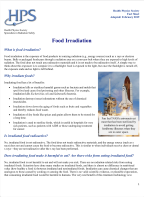Microbial Reduction
High doses of gamma are shown to be effective in killing pathogens such as E.coli, listeria and salmonella in red meat, poultry, fish, shell eggs, fruits, vegetables and spices. Irradiation is done for the safety of people, and changes neither the taste nor the nutrient levels of food.*
*Source: Food Irradiation Processing Alliance (FIPA)
Phytosanitary/Shelf-life Extension
Low doses of gamma are effective in eliminating the risk of introducing foreign insects to other countries. Gamma irradiation delays ripening, inhibits sprouting and extends shelf life, which helps to meet food quarantine standards for export. These and other concerns—such as the growing awareness of the dangers of chemicals which has led countries to review and in some cases suspend their use*—have resulted in an increase in irradiation of food products for phytosanitary and shelf-life extension purposes.
*Source: Irradiation as a phytosanitary treatment of food agricultural commodities, IAEA, 2002
Disinfestation of Spices
From pepper to paprika, from basil to parsley, many spices are disinfected using gamma. Gamma kills insects and prevents food-borne illnesses caused by micro-organisms, without affecting the taste of spices. The American Spice Trade Association provides guidance on the use of irradiation as a microbial reduction strategy for spices.
Disinfestation of Food
In some countries, regulatory requirements and consumer demands are restricting the use of chemical phytosanitary treatments required for the export of fruits and vegetables. The growing awareness of the dangers of chemicals such as Dimethoate, Fenthion, Methylbromide and other known carcinogens has led countries to review and, in some cases, suspend their use. These and other drivers have resulted in an increase in irradiation of food products for phytosanitary purposes as an alternative to chemical treatments. To facilitate the irradiation of high-density low-dose product, businesses partner with Nordion to optimize a unique selectable gamma configuration depending on product type.
Consumer Safety Through Pathogen Reduction
In some countries, gamma irradiation is used to treat meat and produce against micro-organisms such as E. Coli and Salmonella. Irradiation is for the safety of consumers. Food prepared with meat and produce that has been irradiated is indistinguishable in taste and nutrient level from food prepared with non-irradiated ingredients.




